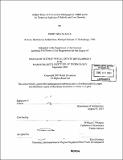Default study of commercial mortgages in CMBS pools : an empirical analysis of defaults and loss severity
Author(s)
Srivastava, Rohit, 1970-
DownloadFull printable version (10.61Mb)
Alternative title
Default study of commercial mortgages in commercial mortgage backed securities pools
Other Contributors
Massachusetts Institute of Technology. Dept. of Architecture.
Advisor
William C. Wheaton.
Terms of use
Metadata
Show full item recordAbstract
The commercial mortgage backed securities ("CMBS") market has become a major source of real estate financing over the last 10-12 years. The growth of this market has been accompanied by strong real estate fundamentals. Consequently the collateral in the CMBS pools has not seen a major real estate recession till now. The loss assumptions used by market participants is based on the experience of banks and insurance companies ("Portfolio Lenders"). As the underwriting criteria and the collateral quality in the CMBS market is markedly different than that of the Portfolio Lenders', it can be assumed that the loss experience is going to be different as well. The loss experience for a portfolio is determined by two main factors, the frequency of defaults (or delinquencies) in the pool and the actual severity of loss on the defaulted loans. Each defaulted loan in a pool represents loss severity and eventual yield degradation. As Real Estate is a lagging indicator, historically, every economic downturn has been followed by a surge in default rates. The recession of 2001-03, which appears to be no different from its predecessors, is also indicative of possible rising commercial mortgage default rates. With further alleviating political risks and no signs of economic recovery in sight, concerns run high investors regarding rising delinquencies and default rates. It is time again, to evaluate the potential yield degradation for truer reflection of the credit risk in the pricing of the CMBS. In an effort to empirically quantify the credit risk and the economic cost of the losses on a portfolio basis, this study examines 801 CMBS deals with 78,680 commercial mortgage loans originated from 1960-2003, tracking them through to June'2003. The effort is focused on evaluating performance of this portfolio, which is mainly representative of mortgages originated by "conduit" lenders. These loans originated mostly with the intention of immediately selling through securitization rather than holding on balance sheet are truly representative of the majority of today's CMBS collateral. The study further examines the possibility of different variables like Debt Service Coverage Ratio, Loan to value, Metropolitan Statistical Areas location and economic growth, impacting the performance of commercial mortgages. This evaluation is based on empirical analysis of this data collected by Intex. The methodology adopted entails a review of the defaulted loans based on factors such as origination cohorts, geographical distribution of defaulting properties, loan sizes, seasoning period, timing of default, number of loans by originator and year, severity of loss, foreclosure process and defaults by property types. Analysis of the different variables helps provide insight into the relationships and importance of these factors in the eventual economic loss or the impact on the imputed yield.
Description
Thesis (S.M.)--Massachusetts Institute of Technology, Dept. of Architecture, 2003. Includes bibliographical references (leaves 57-58).
Date issued
2003Department
Massachusetts Institute of Technology. Department of ArchitecturePublisher
Massachusetts Institute of Technology
Keywords
Architecture.